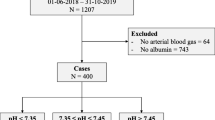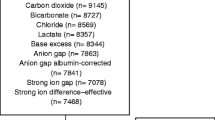Abstract
We aimed to evaluate the sensitivity and specificity of 8 biochemical scanning tools in signalling the presence of unmeasured anions. We used blood gas and biochemical data from 15 patients during and after cardio-pulmonary bypass. Sampling time-points were pre-bypass (T1), 2 min post equilibration with priming fluid containing acetate and gluconate anions (T2), late bypass (T3) and 4 h after surgery (T4). We calculated the anion gap (AG), albumin—corrected anion gap (AGc), whole blood base excess (BE) gap, plasma BE gap, standard BE gap and the strong ion gap (SIG), plus 2 new indices—the unmeasured ion index (UIX) and unmeasured plasma anions according to the interstitial, plasma and erythrocyte acid–base model (IPEua). Total measured plasma concentrations of acetate and gluconate [XA] were proxies for unmeasured plasma anions. [XA] values (mmol/L) were 1.41 (0.87) at T1, 11.73 (3.28) at T2, 4.80 (1.49) at T3 and 1.36 (0.73) at T4. Corresponding [albumin] values (g/L) were 32.3 (2.0), 19.8 (2.6), 21.3 (2.5) and 29.1 (2.3) respectively. Only the AG failed to increase significantly at T2 in response to a mean [XA] surge of >10 mEq/L. At an [XA] threshold of 6 mEq/L, areas under receiver –operator characteristic curves in rank order were IPEua and UIX (0.88 and 0.87 respectively), SIG (0.81), AGc (0.79), standard BE gap (0.77), plasma BE gap (0.71), BE gap (0.70) and AG (0.59). Similar ranking hierarchies applied to positive and negative predictive values. We conclude that during acute hemodilution UIX and IPEua are superior to the anion gap (with and without albumin correction) and 4 other indices as scanning tools for unmeasured anions.



Similar content being viewed by others
References
Morgan TJ. Unmeasured ions and the strong ion gap. In: Kellum JA, Elbers PWG, editors. Stewart’s textbook of acid base. Amsterdam: AcidBase.org; 2009. p. 323–37.
Emmett M, Narins RG. Clinical use of the anion gap. Medicine (Baltimore). 1977;56(1):38–54.
Figge J, Jabor A, Kazda A, Fencl V. Anion gap and hypoalbuminemia. Crit Care Med. 1998;26(11):1807–10.
Jones NL. A quantitative physicochemical approach to acid-base physiology. Clin Biochem. 1990;23(3):189–95.
Kellum JA, Kramer DJ, Pinsky MR. Strong ion gap: A methodology for exploring unexplained anions. J Crit Care. 1995;10(2):51–5.
Gilfix BM, Bique M, Magder S. A physical chemical approach to the analysis of acid-base balance in the clinical setting. J Crit Care. 1993;8(4):187–97.
Boyle M, Lawrence J. An easy method of mentally estimating the metabolic component of acid/base balance using the Fencl-Stewart approach. Anaesth Intensive Care. 2003;31(5):538–47.
Story DA, Morimatsu H, Bellomo R. Strong ions, weak acids and base excess: A simplified Fencl-Stewart approach to clinical acid-base disorders. Br J Anaesth. 2004;92(1):54–60.
Siggaard-Andersen O. The Van Slyke equation. Scand J Clin Lab Invest Suppl. 1977;37(146):15–20.
Siggaard-Andersen O, Fogh-Andersen N. Base excess or buffer base (strong ion difference) as measure of a non-respiratory acid-base disturbance. Acta Anaesthesiol Scand Suppl. 1995;107:123–8.
Wolf MB, Deland EC. A comprehensive, computer-model-based approach for diagnosis and treatment of complex acid-base disorders in critically-ill patients. J Clin Monit Comput. 2011;25(6):353–64. doi:10.1007/s10877-011-9320-2.
Anstey CM. Estimating the net effect of unmeasured ions in human extracellular fluid using a new mathematical model. Part II: Practical issues. Anaesth Intensive Care. 2010;38(5):870–5.
Morgan TJ. Partitioning standard base excess: A new approach. J Clin Monit Comput. 2011;25(6):349–52. doi:10.1007/s10877-011-9324-y.
Balasubramanyan N, Havens PL, Hoffman GM. Unmeasured anions identified by the Fencl-Stewart method predict mortality better than base excess, anion gap, and lactate in patients in the pediatric intensive care unit. Crit Care Med. 1999;27(8):1577–81.
Dondorp AM, Chau TT, Phu NH, Mai NT, Loc PP, Chuong LV, Sinh DX, Taylor A, Hien TT, White NJ, Day NP. Unidentified acids of strong prognostic significance in severe malaria. Crit Care Med. 2004;32(8):1683–8.
Kaplan LJ, Kellum JA. Initial pH, base deficit, lactate, anion gap, strong ion difference, and strong ion gap predict outcome from major vascular injury. Crit Care Med. 2004;32(5):1120–4.
Durward A, Tibby SM, Skellett S, Austin C, Anderson D, Murdoch IA. The strong ion gap predicts mortality in children following cardiopulmonary bypass surgery. Pediatr Crit Care Med. 2005;6(3):281–5. doi:10.1097/01.PCC.0000163979.33774.89.
Murray D, Grant D, Murali N, Butt W. Unmeasured anions in children after cardiac surgery. J Thorac Cardiovasc Surg. 2007;133(1):235–40. doi:10.1016/j.jtcvs.2006.09.017.
Kaplan LJ, Kellum JA. Comparison of acid-base models for prediction of hospital mortality after trauma. Shock. 2008;29(6):662–6. doi:10.1097/shk.0b013e3181618946.
Davies PG, Venkatesh B, Morgan TJ, Presneill JJ, Kruger PS, Thomas BJ, Roberts MS, Mundy J. Plasma acetate, gluconate and interleukin-6 profiles during and after cardiopulmonary bypass: A comparison of Plasma-Lyte 148 with a bicarbonate-balanced solution. Crit Care. 2011;15(1):R21. doi:10.1186/cc9966.
Anstey CM. Estimating the net effect of unmeasured ions in human extracellular fluid using a new mathematical model. Part I: Theoretical considerations. Anaesth Intensive Care. 2010;38(5):862–9.
Wolf MB, Deland EC. A mathematical model of blood-interstitial acid-base balance: Application to dilution acidosis and acid-base status. J Appl Physiol. 2011;110(4):988–1002. doi:10.1152/japplphysiol.00514.2010.
Tosteson AN, Weinstein MC, Wittenberg J, Begg CB. ROC curve regression analysis: The use of ordinal regression models for diagnostic test assessment. Environ Health Perspect. 1994;102(Suppl 8):73–8.
Metz CE, Herman BA, Shen JH. Maximum likelihood estimation of receiver operating characteristic (ROC) curves from continuously-distributed data. Stat Med. 1998;17(9):1033–53.
Shultz EK. Multivariate receiver-operating characteristic curve analysis: Prostate cancer screening as an example. Clin Chem. 1995;41(8 Pt 2):1248–55.
The Merck Index. 15 edn. Cambridge: The Royal Society of Chemistry; 2013.
Kerns W 2nd, Tomaszewski C, McMartin K, Ford M, Brent J. Alcohols MSGMfT Formate kinetics in methanol poisoning. J Toxicol Clin Toxicol. 2002;40(2):137–43.
Moreau CL, Kerns W 2nd, Tomaszewski CA, McMartin KE, Rose SR, Ford MD, Brent J. Glycolate kinetics and hemodialysis clearance in ethylene glycol poisoning. META Study Group. J Toxicol Clin Toxicol. 1998;36(7):659–66.
Kitabchi A, Hirsch IB, Emmett M (2015) Diabetic ketoacidosis and hyperosmolar hyperglycemic state in adults: Clinical features, evaluation and diagnosis. UpToDate. Accessed 20 Jan 2016.
Laffel L. Ketone bodies: A review of physiology, pathophysiology and application of monitoring to diabetes. Diabetes Metab Res Rev. 1999;15(6):412–26.
Anstey CM. An assessment of the population variance of the strong ion gap using Monte Carlo simulation. Anaesth Intensive Care. 2009;37(6):983–91.
Agrafiotis M, Sileli M, Ampatzidou F, Keklikoglou I, Panousis P. The base excess gap is not a valid tool for the quantification of unmeasured ions in cardiac surgical patients: A retrospective observational study. Eur J Anaesthesiol. 2013;30(11):678–84. doi:10.1097/EJA.0b013e32836412db.
Funding
Project supported by Departmental Funds.
Author information
Authors and Affiliations
Corresponding author
Ethics declarations
Conflict of interest
The authors declare that they have no competing interests.
Appendix: preliminary analysis
Appendix: preliminary analysis
Prior to ROC curve analysis, the data were examined to identify a suitable threshold point indicating the presence of XA. Kernel density plots for [XA] for each time sample were constructed and combined into a single summary plot (Fig. 4). On inspection, a threshold point was identified at 6.0 mEq/L. This point was adopted as that which maximised correct classification in each group.
Kernel density plot of the data from times T1, T2, T3 and T4. On the x-axis, XA represents the combined measured plasma concentrations of acetate and gluconate in mEq/L, while the y-axis represents the probability density function for XA. There is a clear inflection point at approximately 6.0 mEq/L which distinguishes results in times T1 and T4 (XA ≤ 6.0 mEq/L) from time T2 (XA > 6.0 mEq/L). Results from time T3 fell into both distributions
Rights and permissions
About this article
Cite this article
Morgan, T.J., Anstey, C.M. & Wolf, M.B. A head to head evaluation of 8 biochemical scanning tools for unmeasured ions. J Clin Monit Comput 31, 449–457 (2017). https://doi.org/10.1007/s10877-016-9861-5
Received:
Accepted:
Published:
Issue Date:
DOI: https://doi.org/10.1007/s10877-016-9861-5





